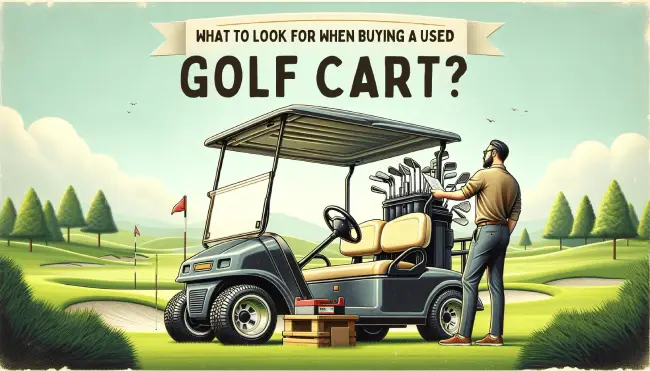Before making a purchase, it’s important to know what to look for when buying a used golf cart to ensure you’re getting a quality vehicle that meets your needs. Buying a used golf cart can be a great way to save money, but it can also be a daunting task if you’re not sure what to consider.
Purchasing a used golf cart requires careful consideration of several factors, from its condition to its price. To help you make the best choice, we have compiled a list of essential aspects to look for when buying a used golf cart. By following these tips, you can avoid any potential disappointments and get the most out of your investment.
Age and Condition: Consider the age and overall condition of the cart
When buying a used golf cart, the age and condition of the vehicle are critical factors to consider. Here’s why:
Age
The age of the golf cart can significantly impact its performance, reliability, and longevity. Older carts may be more prone to mechanical issues, wear and tear, and outdated technology. However, age alone doesn’t determine the condition of the cart, so it’s essential to assess other factors as well.
Overall Condition
Evaluate the overall condition of the golf cart, taking into account factors such as mileage, usage, maintenance history, and storage conditions. Look for signs of wear and tear, damage, or neglect that could affect the cart’s functionality and resale value.
Maintenance Records
Review the maintenance records of the golf cart to determine how well it has been cared for over the years. Regular maintenance and servicing can prolong the lifespan of the cart and ensure optimal performance. A well-documented maintenance history is a positive indicator of the cart’s condition and reliability.
Wear and Tear
Inspect the cart for any signs of excessive wear and tear, such as worn-out components, faded paint, or cracked upholstery. Pay attention to areas that are prone to damage, such as the seats, steering wheel, floor mats, and storage compartments.
Price vs. Condition
Assess the price of the golf cart in relation to its age and condition. While older carts may be more affordable upfront, they may require more frequent repairs and maintenance in the long run. Evaluate whether the asking price aligns with the condition and value of the cart to ensure you’re getting a fair deal.

Battery life and maintenance: Check the battery life and inquire about maintenance history
The battery is a critical component of electric golf carts, powering the vehicle’s motor and electrical systems. When purchasing a used electric golf cart, it’s essential to assess the battery’s life and inquire about its maintenance history. Here’s what you need to know:
Check Battery Age
Determine the age of the batteries installed in the golf cart. Most golf cart batteries have a lifespan of around 4-6 years, depending on usage and maintenance. Older batteries may have reduced capacity and performance, requiring more frequent recharging and replacement.
Battery Type
Consider the type of batteries installed in the golf cart, whether lead-acid, lithium-ion, or other variants. Each battery type has its advantages and disadvantages in terms of performance, lifespan, and maintenance requirements.
Battery Voltage
Test the battery voltage to assess its current state of charge and health. A fully charged golf cart battery should have a voltage reading within the manufacturer’s recommended range. Low voltage readings may indicate a depleted or malfunctioning battery that needs to be replaced.
Inquire About Maintenance
Ask the seller about the battery’s maintenance history, including regular charging practices, watering (for lead-acid batteries), and any past issues or repairs. Well-maintained batteries are more likely to retain their capacity and performance over time.
Visual Inspection
Inspect the batteries visually for any signs of damage, corrosion, or leakage. Check the battery terminals and cables for tightness and corrosion buildup, which can affect electrical conductivity and performance.
Consider Battery Replacement Costs
Factor in the cost of battery replacement when evaluating the overall value of the used golf cart. Determine whether the batteries are nearing the end of their lifespan and budget accordingly for future replacements.

Test drive: Take the cart for a test drive to assess its performance
A test drive is a crucial step in the buying process, allowing you to experience firsthand how the golf cart handles, accelerates, and maneuvers. Here’s why a test drive is essential and how to make the most of it:
Handling and Steering
During the test drive, pay attention to how the golf cart handles and steers. Test the responsiveness of the steering wheel and observe how the cart navigates corners and turns. Smooth and precise steering is essential for a comfortable driving experience.
Acceleration and Speed
Test the acceleration and speed capabilities of the golf cart to ensure it meets your performance expectations. Accelerate gradually and observe how quickly the cart reaches its maximum speed. Check for any sluggishness or hesitations in acceleration, which could indicate underlying issues with the motor or drivetrain.
Braking System
Evaluate the effectiveness of the golf cart’s braking system by applying the brakes gently and progressively. Ensure the brakes engage smoothly and bring the cart to a complete stop without any excessive noise or vibrations. Test the parking brake to verify its functionality and stability when engaged.
Ride Comfort
Assess the ride comfort of the golf cart by driving over different surfaces, including pavement, gravel, and rough terrain. Pay attention to any vibrations, bumps, or rattles that could affect the overall comfort level. A well-maintained golf cart should provide a smooth and stable ride across various terrain types.
Noise and Vibration
Listen for any unusual noises or vibrations during the test drive, which could indicate underlying mechanical issues or component wear. Pay attention to the motor, drivetrain, and suspension system for any signs of abnormal sounds or vibrations.

Additional Features and Accessories of a golf cart
While the basic functionality of a golf cart remains consistent, additional features and accessories can enhance your driving experience and tailor the cart to your specific needs and preferences. Here’s what to consider:
Seating Capacity
Evaluate the seating capacity of the golf cart to ensure it accommodates your intended usage. Whether you’re driving solo or with passengers, choose a cart with sufficient seating capacity for everyone who will regularly ride along.
Storage Space
Assess the storage space available in the golf cart for carrying equipment, personal belongings, and other essentials. Look for features such as under-seat storage compartments, rear cargo beds, or overhead storage racks to accommodate your storage needs.
Weather Protection
If you plan to use the golf cart in various weather conditions, consider features that provide weather protection, such as windshield, canopy, or enclosure options. These accessories can shield you from rain, wind, sun, and other elements while driving.
Lighting and Visibility
Ensure the golf cart is equipped with adequate lighting and visibility features for safe operation, especially during low-light conditions or nighttime driving. Look for headlights, taillights, turn signals, and reflective elements that improve visibility and awareness on the road.
Comfort and Convenience
Consider comfort and convenience features that enhance your driving experience, such as adjustable seats, cup holders, USB charging ports, and dashboard-mounted accessories. Choose a cart with ergonomic design elements and user-friendly controls for maximum comfort and convenience.

Price Negotiation: 6 Tips for Securing a Fair Deal
Negotiating the price of a used golf cart is an essential part of the buying process, allowing you to secure a fair deal that aligns with your budget and expectations. Here are some tips to help you negotiate effectively:
- Do Your Research: Research the market value of similar used golf carts to establish a baseline for negotiation. Consider factors such as the age, condition, features, and mileage of the cart when comparing prices. Knowing the fair market value empowers you to negotiate confidently and avoid overpaying.
- Highlight Areas for Improvement: Identify any areas for improvement or issues with the golf cart that could justify a lower price. Point out any cosmetic flaws, mechanical issues, or maintenance needs during the negotiation process. Use these factors as leverage to negotiate a lower price or request concessions from the seller.
- Be Prepared to Walk Away: Don’t be afraid to walk away from the negotiation if the seller is unwilling to meet your price expectations. Having alternatives and being prepared to explore other options gives you leverage in negotiations and prevents you from settling for an unfair deal. Politely express your willingness to continue the conversation if the seller becomes more flexible.
- Focus on Total Cost: Negotiate based on the total cost of ownership, including any additional fees, taxes, or maintenance expenses. Factor in the cost of any necessary repairs or upgrades that may be required after purchasing the golf cart. Negotiate for a comprehensive deal that addresses all aspects of the transaction to avoid surprises later on.
- Use Timing to Your Advantage: Take advantage of timing to negotiate a better price, such as the end of the month, quarter, or year when sellers may be more motivated to close deals. Keep an eye out for sales promotions, clearance events, or seasonal discounts that could work in your favor. Be patient and strategic in your approach to maximize savings.
- Maintain a Positive Relationship: Approach negotiations with a cooperative and respectful attitude to maintain a positive relationship with the seller. Building rapport and fostering goodwill can lead to more favorable outcomes and concessions during negotiations. Keep communication open and professional throughout the process to facilitate a mutually beneficial agreement.
FAQs
Q: How important is the battery condition in a used golf cart?
A: Very important. For electric carts, the battery is a significant component. Check the age, condition, and brand of the battery. Replacing batteries can be costly, so factor this into your decision.
Q: Should I consider a gas or electric golf cart?
A: This depends on your needs. Electric carts are quieter and generally have lower operating costs, while gas carts can cover longer distances and are not reliant on charging stations.
Q: Is it better to buy from a dealer or a private seller?
A: Dealers may offer warranties and certified pre-owned options, while private sellers might have lower prices. Consider what’s more important for you: the security of a warranty or the potential for a lower cost.
Q: What about the maintenance history of the golf cart?
A: Ask for maintenance records to understand how well the golf cart was taken care of. Regular maintenance is a good indicator of a reliable cart.
Q: What are the key mechanical aspects to inspect?
A: Test drive the cart to check its braking, steering, and suspension system. Listen for any unusual noises that could indicate mechanical issues.







